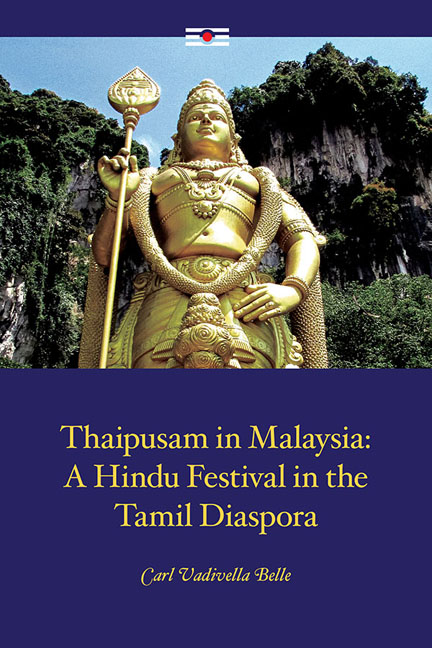Book contents
- Frontmatter
- Contents
- Acknowledgements
- Introduction
- 1 Indians in Malaysia: The Social and Ethnic Context
- 2 Tamil Traditions and South Indian Hinduism
- 3 Colonialism, Colonial Knowledge and Hindu Reform Movements
- 4 Hinduism in Malaysia: An Overview
- 5 Murugan: A Tamil Deity
- 6 The Phenomenology of Thaipusam at Batu Caves
- 7 Other Thaipusams
- 8 Thaipusam Considered: The Divine Crossing
- Conclusions
- Glossary
- Bibliography
- Index
- About the Author
5 - Murugan: A Tamil Deity
Published online by Cambridge University Press: 12 January 2018
- Frontmatter
- Contents
- Acknowledgements
- Introduction
- 1 Indians in Malaysia: The Social and Ethnic Context
- 2 Tamil Traditions and South Indian Hinduism
- 3 Colonialism, Colonial Knowledge and Hindu Reform Movements
- 4 Hinduism in Malaysia: An Overview
- 5 Murugan: A Tamil Deity
- 6 The Phenomenology of Thaipusam at Batu Caves
- 7 Other Thaipusams
- 8 Thaipusam Considered: The Divine Crossing
- Conclusions
- Glossary
- Bibliography
- Index
- About the Author
Summary
Cosmic History
The deity Murugan has been closely identified with Tamil religiosity for at least two millennia. Descriptions of Murugan are contained within early Tamil literature, including the substantial corpus of Sangam poetry. In his landmark study, The Many Faces of Murukan — The History and Meaning of a South Indian God, Fred W. Clothey points out that throughout the Sangam period Tamil culture progressively absorbed elements of the Sanskrit culture of the Aryan North. The later portrayals of Murugan reflect the admixture of these northern influences and thus differ markedly from those found within the earlier poetry.
In the earliest phase of Sangam literature, Murugan is clearly depicted as a rural deity, and is firmly identified with the kurinci tinai (hilly ecozone) of the Tamil country, and hence the tinai's people. The deity is also regarded as the god of the hunt, and indeed Asim Kumar Chatterjee postulates that Murugan may have been the patron god of the Karuvars, or hunting tribes. In this guise, Murugan's enemy is the cur (soor), a demon who ranges the countryside randomly seeking out and possessing young women. In early literature the cur is viewed as an actual physical manifestation whose very presence produces terror. However, over time, the cur transforms into the cura, whom Murugan defeats in battle, initially with a specially shaped leaf, but later with a leaf-shaped lance. Murugan's intense heroism is portrayed in many love poems. He is clearly identified as a god who generates paroxysms of excitement among girls and young women; indeed he becomes established as the patron of premarital love. He is also represented as a deity both adept at creating and dispelling suffering (ananku). The red colour of the god is constantly reiterated, and he is thus known as Ceyon/Seyon (“The Red One”). Murugan is closely associated with the elephant and the peacock, the latter assuming a major role as the deity's mount.
Throughout the later Sangam era — a period of urbanization and the establishment of kings in the Tamil country — Murugan incorporates additional roles and motifs. His identity moves beyond the kurinci tinai to gain acceptance in other tinai within the Tamilakam, namely the forests (Mullai), the plains (Marutum), the dry and semi-dry zones (Palai), and the littoral (Neital).
- Type
- Chapter
- Information
- Thaipusam in MalaysiaA Hindu Festival in the Tamil Diaspora, pp. 134 - 184Publisher: ISEAS–Yusof Ishak InstitutePrint publication year: 2017

